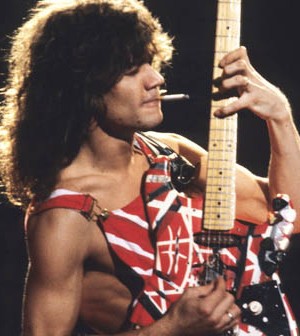Eddie Van Halen – Guitar God Profile
By Carlos GGS on 09/16/2014

#3: Eddie Van Halen
- Born: January 26, 1955
- If it’s face melting guitar solos you want, Eddie doesn’t disappoint with his body of work – the greatest of which, according to rock critics, is his signature handiwork from Van Halen’s instrumental track called “Eruption” – check out the super extended live version here:
- Eddie added his personal touch to the blues-based technique known as tapping in the Eruption solo, burning the song into the collective memories of millions of fans around the world.
- Although other artists have employed tapping, Eddie gave a distinct, two-handed heavy metal edge to his handiwork to make his famous solo all his own.
- Ironically, Eddie had no formal training (similar to Jimmy Page, one of his musical influences) and never bothered to read music which makes his mastery of tapping, harmonics, tremolo picking and vibrato all the more amazing.
- Since Eddie was too busy rocking out to stadiums around the world, he also didn’t bother learning the technical intricacies of crafting his infamous Frankenstrat axe.
- As the name suggests, it’s a clever wordplay of the iconic movie monster and the Fender Stratocaster. Using a freaky combination of various components including a Fender tremolo, molten surfboard wax and a vastly simplified electrical control system (Eddie did away with the other tone controls and his pickups fed only into a single volume control with a knob labeled “tone”), this DIY project that helped Eddie become the world-class Guitar God that he is today.
- Another one of Eddie’s innovations is a patented guitar support device to stabilize his axe. Thanks to this unprecedented device, he could turn any stringed instrument into a upward facing one, so he could bust out a two-handed tapping solo using all of his available fingers. Yes, he literally created a new technology to suit a need that he himself created.
- By hammering notes on his fretboard and adjusting the volume control at the same time, Eddie was able to manipulate the attack and delay of his notes. The result was a organ keyboard-like effect on the aptly titled instrumental track “Catherdral”:
- Above all, Eddie was a tone connoisseur and came up with the distinct but elusive “brown sound”. The technical process of replicating the brown sound is a subject of raging debate among guitarists.
- He describes it as a natural result of his own personality, saying that it’s “basically a tone, a feeling that I’m always working at … It comes from the person. If the person doesn’t even know what that type of tone I’m talking about is, they can’t really work towards it, can they?”
- Eddie’s solos often had little breaks in between by using the vibrato bar. Using his ubiquitous Frankestrat’s vibrato setup, he created bar dips and dives on different levels.
- One of Eddie’s other famous techniques was to pick the high strings and hammer a bassline on the low strings as he did on the song “Little Guitars” to create that classical guitar-sounding intro.
- He did this to completely bypass finger-picking, which he claims he couldn’t do. Instead, he picked a single-note trill with his right hand (hitting the high E string). Meanwhile, his left hand was for hammer-on and pull-off duty so he could play the melody on the A and D strings. Hear it for yourself:
- Perphaps the most accessible, stadium-friendly track from Van Halen is “Jump”, and this marked the band’s leap into more commercial territory. Eddie’s synth-heavy solo (and intro) is proof their shift towards a different style, which many say prompted singer David Lee Roth to leave Van Halen. Here’s their 1995 performance of the classic:






You must be logged in to post a comment Login